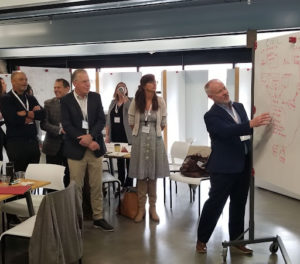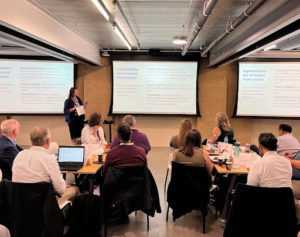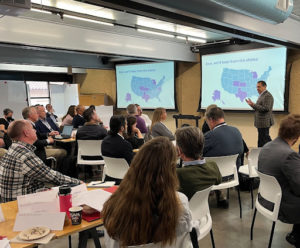Filing Fairness Project Leads Court and Justice Tech Collaboration
State court leaders and administrators from Alaska, Colorado, Kansas, Michigan, Texas, and Virginia, along with technology providers from 18 organizations, ranging from large, for-profit companies to small, non-profits, came together at Stanford’s d.school on October 14th to take the next steps in Stanford’s Filing Fairness Project. This all-day working session, led by Stanford Law School’s Deborah M. Rhode Center on the Legal Profession and Stanford’s Legal Design Lab, brought together technology providers and court leaders to discuss the future of easy-to-use, multi-jurisdictional efiling tools, particularly for self-represented litigants.

A Tech Summit to Build a Better Justice Tech Ecosystem
The Filing Fairness Project is a multi-jurisdictional effort to improve access to justice by simplifying court filing processes and enabling high-quality form tools for lawyers and litigants. Stanford hosted a kick-off summit in March, where justice leaders came together to plan how to collaborate across jurisdictions and how to scale promising technology initiatives. At the kick-off, court leaders demonstrated their commitment to improving court users’ experiences in finding and using technology tools that can make it easier for a person to file a name change request, respond to an eviction lawsuit, or ask the court to waive its fees.
The Stanford team has also been building a network of technology providers who build case management software, efiling systems, and document assembly tools. To get high-quality justice solutions at scale, there needs to be an improved ecosystem of technology solutions and court infrastructure. Our team has been identifying the stakeholders in the current ecosystem and what they need to improve the quality and reach of their user-facing technology. Starting with our class teams from Stanford’s Policy Lab courses and then continuing throughout the year, we have spoken with technology companies, non-profits, and university labs to identify who is building which technology tools and what they need to build more sustainable, high-performing solutions.
The Filing Fairness Project Tech Summit brought this range of court leaders, advocates, and technologists together to make a clearer plan of how to advance this ecosystem and better serve court users across the country. The Summit was structured around three pillars of possible collaboration: 1) coordinating form fields; 2) streamlining efiling access, burdens, and protocols; and 3) establishing court leader and technology provider partnerships. The Stanford team gave an overview about the national landscape of court technologies and the project’s mission, and Jim Cabral presented on the current efiling software providers across the country. Court leaders and technology providers then went through the three pillars, exploring the next steps for each of them.
For the form field coordination pillar, the Stanford team presented a prototype data dictionary containing multiple states’ form fields in one standardized database. The form field dictionary was designed with several complementary goals. First, technology providers might use the database to understand what fields are used in which forms, and by which jurisdictions. Second, court leaders might use it to examine over-complexity in their forms and compare their approach to other states’ approaches. We also hoped to spur conversation about how a comprehensive database could generally help facilitate cross-jurisdictional tools. Technology providers gave us feedback about how the data dictionary could be useful, potential pitfalls in designing a court-oriented data standard, and what scalability and maintainability might look like. Court leaders gave us feedback about what information—for example, whether a field is truly optional in a given jurisdiction—should be added to the prototype.

For the streamlining efiling pillar, court leaders and technology providers discussed efiling access, burdens, and protocols across the states. Each state presented their existing efiling flow (and how it differed for self-represented litigants and lawyers) to rotating groups of technology providers. States discussed plans for reducing administrative burdens and how technology providers could plug into their efiling infrastructure. This helped technology providers understand the existing burdens to efiling, the similarities and differences from state to state, and the procedural improvements that court leaders are working with our team to make.
Finally, for the relationship building pillar, technology providers and court leaders met in small groups to explore future partnerships. After a lively series of breakout discussions, the broader group reconvened to discuss the top priorities that came up during these smaller conversations. Among other topics, we discussed the importance of finding values-aligned and maintainable business models and providing clarity for technology providers about when, if, and how courts would be willing to promote their tools. The attendees agreed that improving efiling–including for self-represented litigants–is not a problem of technology, but one of encouraging, facilitating, and managing change.
The Next Steps for the Filing Fairness Project

We heard one major piece of feedback throughout the day: these kinds of cross-jurisdictional, multi-stakeholder working sessions rarely ever happen, and they need to happen more. All the different stakeholders were enthusiastic about the Filing Fairness Project’s work to create a more coherent national ecosystem around efiling, user-facing tools, and court infrastructure.
Court leaders and tech providers agreed that there is an access to justice problem for self-represented litigants, and there are clear opportunities to use improved technology to address it. They also agreed that unnecessary filing burdens–a major part of this problem–impact litigants, lawyers, and legal aid organizations alike. Many attendees emphasized the value in getting these stakeholders in the same room and organized around a common goal. One provider put it best: “I’m left with the memory of the amazing day spent with all of you looking at court efiling systems and meeting all sorts of mission-driven organizations and tech providers.”
One of the key goals of the Summit was to build working relationships between court leaders and technology providers in order to identify which kinds of technologies, policies, and other initiatives can help them build better solutions for court users. The Stanford team was delighted to see such active conversations throughout the Summit, and we are following up with individual stakeholders to learn more about where they saw fruitful tool development opportunities, what barriers they still face, and what Stanford can do to facilitate ongoing work.
Stakeholders from both the courts and the technology companies emphasized that the Filing Fairness Project can play an important role in change management. This may include driving discussions to help states standardize their form fields or efiling requirements, including through more research, user testing, and policy-mapping. It may involve working with courts to provide certification pathways for technology providers or to understand how and when the courts can neutrally promote efiling tools developed by the Project’s providers. It may also involve establishing guidance for technology providers around setting up court partnerships or integrations with court technology systems. Our follow-up conversations will help us understand where Stanford can be most useful, and we look forward to communicating progress on these initiatives.
Your Next Steps
If you did not attend the Tech Summit but are interested in participating in the Filing Fairness Project, please complete this Google Form and subscribe to the DLR CLP blog.
